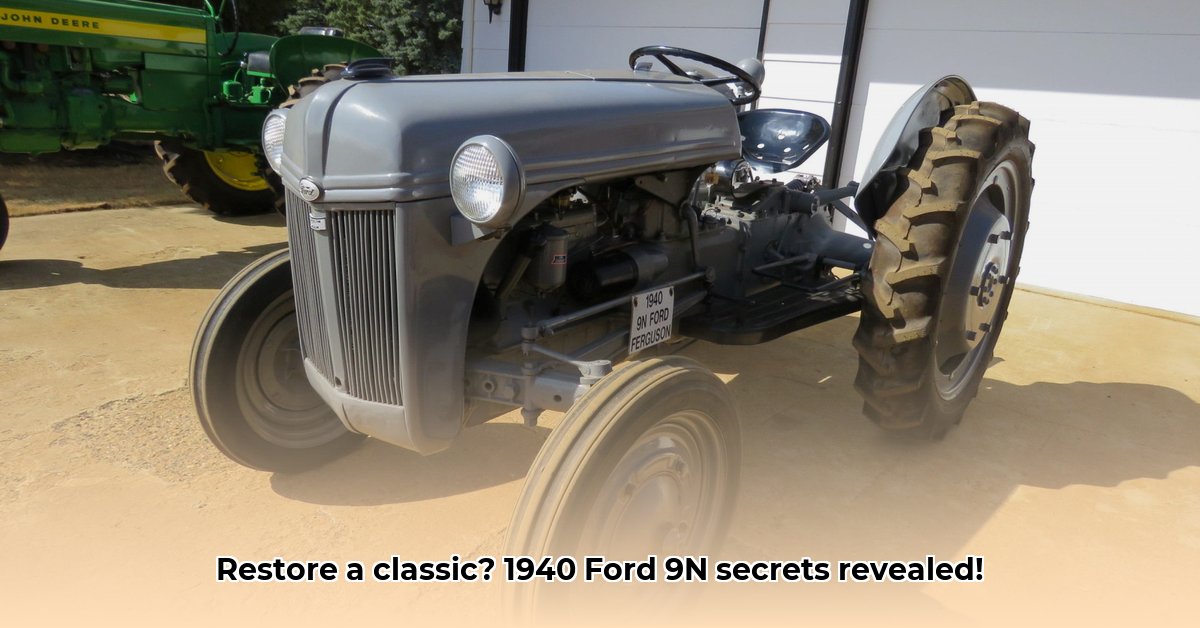
The 1940 Ford 9N tractor – a name whispered with reverence among classic tractor enthusiasts. More than just a machine, it represents a pivotal moment in agricultural history and a testament to enduring American ingenuity. But beyond its historical significance, what makes these tractors so desirable today, and how can you navigate the market to acquire and restore one? This guide provides a comprehensive overview of the Ford 9N's value, restoration, and acquisition process. For more in-depth information, check out this helpful resource: Ford 9N Info.
A Legacy Forged in Steel: The 9N's Historical Impact
The year is 1940. The world is grappling with global conflict, but on American farms, a revolution is underway. Henry Ford, already a legend in automotive manufacturing, introduces the 9N tractor, a machine that would forever change the landscape of agriculture. Its groundbreaking three-point hitch system (a mechanism that simplifies attaching and detaching implements) drastically increased efficiency, allowing farmers to quickly swap tools and optimize their workflow. This simple yet brilliant innovation set the 9N apart from its contemporaries, solidifying its place in agricultural history. This wasn't just about brute force; it was about intelligent design and practicality – qualities that resonate with collectors even today. What other innovations of the era compared to the Ford 9N's impact on farming?
Decoding the Value: Factors Affecting a 1940 Ford 9N's Price
The market value of a 1940 Ford 9N tractor is not a fixed number; it's a dynamic equation influenced by several key variables. Think of it like assessing a classic car; originality and condition are paramount. Several factors can significantly impact the final price:
Condition: A meticulously restored 9N, gleaming with original paint and perfectly functioning mechanics, will command a significantly higher price than a project tractor needing extensive work. A fully restored example can easily demand a premium.
Year of Manufacture: Early production models, particularly those from 1939, tend to be more valuable due to their rarity and historical significance. Minor variations in features across the production run can influence collector demand.
Accessories: The presence of original implements (plows, cultivators, etc.) significantly increases value. A complete, original setup is highly sought after by collectors.
Location: Geographic location influences the market value. Demand fluctuates regionally, impacting prices. Transportation costs can also be a significant factor.
Estimated Price Range (USD): (Note: These are rough estimates and can fluctuate greatly based on the specific condition and factors mentioned above)
| Condition | Approximate Price Range (USD) |
|---|---|
| Fully Restored, Exceptional | $20,000 - $40,000+ |
| Good, Mostly Original | $10,000 - $20,000 |
| Project Tractor, Needs Work | $5,000 - $10,000 |
Isn't it fascinating how such a seemingly simple machine can hold such varied value? What other factors might influence these price points?
The Acquisition Quest: Sourcing Your 1940 Ford 9N
Finding the right 1940 Ford 9N requires diligent searching and a keen eye. Here’s how to start your journey:
Online Marketplaces: Specialized online marketplaces and auction sites often feature vintage farm equipment listings.
Live Auctions: Live auctions offer a thrilling, albeit sometimes unpredictable, opportunity to acquire a tractor. Thorough research beforehand is essential.
Private Sellers: Networking within the classic tractor community can lead to hidden gems. Don't hesitate to contact restoration shops or enthusiasts.
Before buying, a meticulous inspection is critical:
Mechanical Assessment: A thorough evaluation of the engine, transmission, hydraulics, and three-point hitch system is absolutely essential. Consider enlisting a qualified mechanic for a professional assessment.
Body Inspection: Examine for rust, dents, and damage. Document everything with detailed photos. Is the paint original?
Paperwork: Ensure you have proper documentation, such as original manuals and registration papers, if applicable.
What unforeseen challenges might you encounter during this process?
Restoration: A Journey of Passion and Patience
Restoring a 1940 Ford 9N is a challenging yet deeply rewarding project. It's a true labor of love demanding patience, skill, and resourcefulness.
Parts Procurement: Sourcing original parts can be difficult and expensive. Aftermarket replacements, custom fabrication, and online forums dedicated to classic tractor restoration are often valuable resources.
Skills and Tools: Welding, machining, and painting skills might be required. Don’t hesitate to seek professional assistance for specialized tasks.
Authenticity vs. Functionality: Decide between a completely original restoration (a truly impressive feat) or a functional machine that prioritizes reliability over strict historical accuracy. Knowing your priorities is essential.
How long might a complete restoration take, and what are the possible stumbling blocks?
Maintaining Your Legacy: Preserving Your 9N
After restoration, regular maintenance is crucial to preserve your investment. Scheduled oil changes, lubrication, and thorough cleaning will keep your 9N in top operating condition. Preventative maintenance is key to ensuring longevity.
This guide provides a starting point for anyone interested in the captivating world of the 1940 Ford 9N. Remember, acquiring and restoring a classic tractor is a significant undertaking. Thorough research, expert advice, and a healthy dose of patience are essential ingredients for success. Happy hunting!